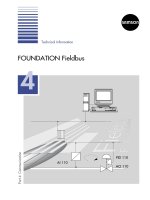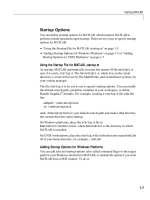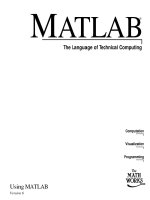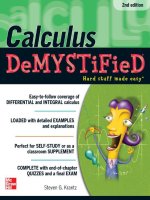Technical math demystified
Bạn đang xem bản rút gọn của tài liệu. Xem và tải ngay bản đầy đủ của tài liệu tại đây (5.27 MB, 432 trang )
TECHNICAL MATH
DEMYSTIFIED
Demystified Series
Accounting Demystified
Advanced Statistics Demystified
Algebra Demystified
Anatomy Demystified
asp.net 2.0 Demystified
Astronomy Demystified
Biology Demystified
Biotechnology Demystified
Business Calculus Demystified
Business Math Demystified
Business Statistics Demystified
C++ Demystified
Calculus Demystified
Chemistry Demystified
College Algebra Demystified
Corporate Finance Demystified
Data Structures Demystified
Databases Demystified
Differential Equations Demystified
Digital Electronics Demystified
Earth Science Demystified
Electricity Demystified
Electronics Demystified
Environmental Science Demystified
Everyday Math Demystified
Forensics Demystified
Genetics Demystified
Geometry Demystified
Home Networking Demystified
Investing Demystified
Java Demystified
JavaScript Demystified
Linear Algebra Demystified
Macroeconomics Demystified
Management Accounting Demystified
Math Proofs Demystified
Math Word Problems Demystified
Medical Terminology Demystified
Meteorology Demystified
Microbiology Demystified
Microeconomics Demystified
Nanotechnology Demystified
OOP Demystified
Options Demystified
Organic Chemistry Demystified
Personal Computing Demystified
Pharmacology Demystified
Physics Demystified
Physiology Demystified
Pre-Algebra Demystified
Precalculus Demystified
Probability Demystified
Project Management Demystified
Psychology Demystified
Quality Management Demystified
Quantum Mechanics Demystified
Relativity Demystified
Robotics Demystified
Six Sigma Demystified
SQL Demystified
Statistics Demystified
Technical Math Demystified
Trigonometry Demystified
UML Demystified
Visual Basic 2005 Demystified
Visual C# 2005 Demystified
XML Demystified
TECHNICAL MATH
DEMYSTIFIED
STAN GIBILISCO
McGRAW-HILL
New York Chicago San Francisco Lisbon London
Madrid Mexico City Milan New Delhi San Juan
Seoul Singapore Sydney Toronto
Copyright © 2006 by The McGraw-Hill Companies, Inc. All rights reserved. Manufactured in the United States of America. Except
as permitted under the United States Copyright Act of 1976, no part of this publication may be reproduced or distributed in any form
or by any means, or stored in a database or retrieval system, without the prior written permission of the publisher.
0-07-149202-X
The material in this eBook also appears in the print version of this title: 0-07-145949-9.
All trademarks are trademarks of their respective owners. Rather than put a trademark symbol after every occurrence of a trademarked name, we use names in an editorial fashion only, and to the benefit of the trademark owner, with no intention of infringement of the trademark. Where such designations appear in this book, they have been printed with initial caps.
McGraw-Hill eBooks are available at special quantity discounts to use as premiums and sales promotions, or for use in corporate
training programs. For more information, please contact George Hoare, Special Sales, at or (212)
904-4069.
TERMS OF USE
This is a copyrighted work and The McGraw-Hill Companies, Inc. (“McGraw-Hill”) and its licensors reserve all rights in and to the
work. Use of this work is subject to these terms. Except as permitted under the Copyright Act of 1976 and the right to store and
retrieve one copy of the work, you may not decompile, disassemble, reverse engineer, reproduce, modify, create derivative works
based upon, transmit, distribute, disseminate, sell, publish or sublicense the work or any part of it without McGraw-Hill’s prior consent. You may use the work for your own noncommercial and personal use; any other use of the work is strictly prohibited. Your right
to use the work may be terminated if you fail to comply with these terms.
THE WORK IS PROVIDED “AS IS.” McGRAW-HILL AND ITS LICENSORS MAKE NO GUARANTEES OR WARRANTIES
AS TO THE ACCURACY, ADEQUACY OR COMPLETENESS OF OR RESULTS TO BE OBTAINED FROM USING THE
WORK, INCLUDING ANY INFORMATION THAT CAN BE ACCESSED THROUGH THE WORK VIA HYPERLINK OR OTHERWISE, AND EXPRESSLY DISCLAIM ANY WARRANTY, EXPRESS OR IMPLIED, INCLUDING BUT NOT LIMITED TO
IMPLIED WARRANTIES OF MERCHANTABILITY OR FITNESS FOR A PARTICULAR PURPOSE. McGraw-Hill and its
licensors do not warrant or guarantee that the functions contained in the work will meet your requirements or that its operation will
be uninterrupted or error free. Neither McGraw-Hill nor its licensors shall be liable to you or anyone else for any inaccuracy, error
or omission, regardless of cause, in the work or for any damages resulting therefrom. McGraw-Hill has no responsibility for the content of any information accessed through the work. Under no circumstances shall McGraw-Hill and/or its licensors be liable for any
indirect, incidental, special, punitive, consequential or similar damages that result from the use of or inability to use the work, even
if any of them has been advised of the possibility of such damages. This limitation of liability shall apply to any claim or cause whatsoever whether such claim or cause arises in contract, tort or otherwise.
DOI: 10.1036/0071459499
To Samuel, Tim, and Tony
This page intentionally left blank
For more information about this title, click here
CONTENTS
Preface
xiii
Acknowledgments
xv
CHAPTER 1
Numbering Systems
Sets
Denumerable Number Sets
Bases 10, 2, 8, and 16
Nondenumerable Number Sets
Special Properties of Complex Numbers
Quick Practice
Quiz
1
1
6
10
15
20
24
27
CHAPTER 2
Principles of Calculation
Basic Principles
Miscellaneous Principles
Advanced Principles
Approximation and Precedence
Quick Practice
Quiz
29
29
33
37
42
46
47
CHAPTER 3
Scientific Notation
Powers of 10
Calculations in Scientific Notation
Significant Figures
Quick Practice
Quiz
51
51
57
61
65
67
vii
viii
CONTENTS
CHAPTER 4
Coordinates in Two Dimensions
Cartesian Coordinates
Simple Cartesian Graphs
Polar Coordinates
Navigator’s Coordinates
Coordinate Conversions
Other Coordinate Systems
Quick Practice
Quiz
71
71
74
80
87
89
92
99
101
CHAPTER 5
Coordinates in Three Dimensions
Cartesian 3-Space
Other 3D Coordinate Systems
Hyperspace
Quick Practice
Quiz
105
105
108
113
119
122
CHAPTER 6
Equations in One Variable
Operational Rules
Linear Equations
Quadratic Equations
Higher-Order Equations
Quick Practice
Quiz
125
125
127
130
134
137
139
CHAPTER 7
Multivariable Equations
2×2 Linear Equations
3×3 Linear Equations
2×2 General Equations
Graphic Solution of Pairs of Equations
Quick Practice
Quiz
143
143
148
152
154
158
160
ix
CONTENTS
CHAPTER 8
Perimeter and Area in Two Dimensions
Triangles
Quadrilaterals
Regular Polygons
Circles and Ellipses
Other Formulas
Quick Practice
Quiz
163
163
166
171
172
175
180
182
CHAPTER 9
Surface Area and Volume in
Three Dimensions
Straight-Edged Objects
Cones and Cylinders
Other Solids
Quick Practice
Quiz
185
185
191
198
202
204
CHAPTER 10
Boolean Algebra
Operations, Relations, and Symbols
Truth Tables
Some Boolean Laws
Quick Practice
Quiz
207
207
212
216
220
223
CHAPTER 11
Trigonometric Functions
The Unit Circle
Primary Circular Functions
Secondary Circular Functions
The Right Triangle Model
Trigonometric Identities
Quick Practice
Quiz
227
227
229
232
234
237
245
248
x
CONTENTS
CHAPTER 12
Vectors in Two and Three Dimensions
Vectors in the Cartesian Plane
Vectors in the Polar Plane
Vectors in Cartesian 3-Space
Standard Form of a Vector
Basic Properties
Other Properties
Quick Practice
Quiz
251
251
256
259
264
267
275
278
280
CHAPTER 13
Logarithmic and Exponential Functions
Logarithmic Functions
How Logarithmic Functions Behave
Exponential Functions
How Exponential Functions Behave
Quick Practice
Quiz
283
284
287
290
293
298
300
CHAPTER 14
Differentiation in One Variable
Definition of the Derivative
Properties of Derivatives
Properties of Curves
Derivatives of Wave Functions
Quick Practice
Quiz
305
305
311
315
323
329
331
CHAPTER 15
Integration in One Variable
What Is Integration?
Basic Properties of Integration
A Few More Formulas
Integrals of Wave Functions
Examples of Definite Integration
Quick Practice
Quiz
337
337
341
343
348
354
358
361
xi
CONTENTS
Final Exam
365
Answers to Quiz and Exam Questions
395
Suggested Additional Reading
399
Index
401
This page intentionally left blank
PREFACE
This book is written for people who want to refresh or improve their mathematical skills, especially in fields applicable to science and engineering. The course
can be used for self-teaching without the aid of an instructor, but it can also be
useful as a supplement in a classroom, tutored, or home-schooling environment.
If you are changing careers, and your new work will involve more mathematics
than you’ve been used to doing, this book should help you prepare.
If you want to get the most out of this book, you should have completed
high-school algebra, high-school geometry and trigonometry, and a first-year
course in calculus. You should be familiar with the concepts of rational, real, and
complex numbers, linear equations, quadratic equations, the trigonometric functions, coordinate systems, and the differentiation and integration of functions in
a single variable.
This book contains plenty of examples and practice problems. Each chapter
ends with a multiple-choice quiz. There is a multiple-choice final exam at the
end of the course. The questions in the quizzes and the exam are similar in format to the questions in standardized tests.
The chapter-ending quizzes are open-book. You may refer to the chapter texts
when taking them. When you think you’re ready, take the quiz, write down your
answers, and then give your list of answers to a friend. Have the friend tell you
your score, but not which questions you got wrong. The answers are listed in
the back of the book. Stick with a chapter until you get most, and preferably all,
of the quiz answers correct.
The final exam contains questions drawn uniformly from all the chapters. It
is a closed-book test. Don’t look back at the text when taking it. A satisfactory
score is at least three-quarters of the answers correct (I suggest you shoot for
90 percent). With the final exam, as with the quizzes, have a friend tell you your
score without letting you know which questions you missed. That way, you will
xiii
Copyright © 2006 by The McGraw-Hill Companies, Inc. Click here for terms of use.
xiv
PREFACE
not subconsciously memorize the answers. You can check to see where your
knowledge is strong and where it is weak.
I recommend that you complete one chapter a week. An hour or two daily
ought to be enough time for this. When you’re done with the course, you can use
this book as a permanent reference.
Suggestions for future editions are welcome.
STAN GIBILISCO
ACKNOWLEDGMENTS
I extend thanks to my nephew Tony Boutelle, a student at Macalester College in
St. Paul. He spent many hours helping me proofread the manuscript, and he
offered insights and suggestions from the point of view of the intended audience.
xv
Copyright © 2006 by The McGraw-Hill Companies, Inc. Click here for terms of use.
This page intentionally left blank
TECHNICAL MATH
DEMYSTIFIED
This page intentionally left blank
CHAPTER
1
Numbering Systems
This chapter covers the basic properties of sets and numbers. Familiarity with
these concepts is important in order to gain a solid working knowledge of
applied mathematics. For reference, and to help you navigate the notation you’ll
find in this book, Table 1-1 lists and defines the symbols commonly used in technical mathematics.
Sets
A set is a collection or group of definable elements or members. A set element
can be anything—even another set. Some examples of set elements in applied
mathematics and engineering are:
• Points on a line
• Instants in time
1
Copyright © 2006 by The McGraw-Hill Companies, Inc. Click here for terms of use.
2
CHAPTER 1
Numbering Systems
Table 1-1. Symbols commonly used in mathematics.
Symbol
Description
Symbol
Description
()
Quantification; read “ the quantity”
⊆ Subset; read “is a subset of”
[]
Quantification; used outside ( )
∈ Element; read “is an element of” or “is a member of”
{ } Quantification; used outside [ ]
{ } Braces; objects between them are elements of
a set
⇒
Logical implication or “if/then” operation; read
“implies”
⇔ Logical equivalence; read “if and only if”
∉ Nonelement; read “ is not an element of” or “ is
not a member of”
= Equality; read “equals” or “is equal to”
≠ Not-equality; read “does not equal” or “ is not
equal to”
≈ Approximate equality; read “is approximately
equal to”
∀
Universal quantifier; read “For all” or “For
every”
∃
Existential quantifier; read “For some”
:
Logical expression; read “such that”
≤ Equality or inequality; read “ is less than or
equal to”
Logical expression; read “such that”
> Inequality; read “ is greater than”
&
Logical conjunction; read “and”
∨
Logical disjunction; read “or”
≥ Equality or inequality; read “ is greater than or
equal to”
¬
Logical negation; read “not”
+ Addition; read “plus”
N
The set of natural numbers
− Subtraction, read “minus”
Z
The set of integers
× Multiplication; read “ times” or “multiplied by”
Q
The set of rational numbers
∗ Multiplication; read “ times” or “multiplied by”
R
The set of real numbers
ℵ
Transfinite (or infinite) cardinal number
∅
The set with no elements; read “the empty set”
or “the null set”
< Inequality; read “ is less than”
·
Multiplication; read “ times” or “multiplied by”
÷ Quotient; read “over” or “divided by”
/
Quotient; read “over” or “divided by”
!
Product of all natural numbers from 1 up to a
certain value; read “ factorial”
∩
Set intersection; read “intersect”
∪
Set union; read “union”
× Cross (vector) product of vectors; read “cross”
⊂
Proper subset; read “is a proper subset of”
• Dot (scalar) product of vectors; read “dot”
CHAPTER 1 Numbering Systems
•
•
•
•
•
•
•
•
Coordinates in a plane.
Coordinates in space.
Points, lines, or curves on a graph.
Digital logic states.
Data bits, bytes, or characters.
Subscribers to a network.
Wind-velocity vectors at points in the eyewall of a hurricane.
Force vectors at points along the length of a bridge.
If an element a is contained in a set A, then the fact is written like this:
a∈A
SET INTERSECTION
The intersection of two sets A and B, written A ∩ B, is the set C consisting of
the elements in both sets A and B. The following statement is valid for every
element x:
x ∈ C if and only if x ∈ A and x ∈ B
SET UNION
The union of two sets A and B, written A ∪ B, is the set C consisting of the
elements in set A or set B (or both). The following statement is valid for every
element x:
x ∈ C if and only if x ∈ A or x ∈ B
COINCIDENT SETS
Two nonempty sets A and B are coincident if and only if they are identical. That
means that for all elements x, the following statements are both true:
If x ∈ A, then x ∈ B
If x ∈ B, then x ∈ A
3
4
CHAPTER 1
B
A
A
Numbering Systems
B
Fig. 1-1. The intersection of two nondisjoint, noncoincident sets A and B.
DISJOINT SETS
Two sets A and B are disjoint if and only if both sets contain at least one element,
but there is no element that is in both sets. All three of the following conditions
must be met:
A≠∅
B≠∅
A∩B=∅
where ∅ denotes the empty set, also called the null set.
VENN DIAGRAMS
The intersection and union of nonempty sets can be conveniently illustrated by
Venn diagrams. Figure 1-1 is a Venn diagram that shows the intersection of two
sets that are nondisjoint (they overlap) and noncoincident (they are not identical). Set A ∩ B is the cross-hatched area, common to both sets A and B. Figure
1-2 shows the union of the same two sets. Set A ∪ B is the shaded area, representing elements that are in set A or in set B, or both.
SUBSETS
A set A is a subset of a set B, written A ⊆ B, if and only if any element x in set
A is also in set B. The following logical statement holds true for all elements x:
If x ∈ A, then x ∈ B
5
CHAPTER 1 Numbering Systems
B
A
A
B
Fig. 1-2. The union of two non-disjoint,
noncoincident sets A and B.
PROPER SUBSETS
A set A is a proper subset of a set B, written A ⊂ B, if and only if any element x
in set A is in set B, but the two sets are not coincident. The following logical
statements both hold true for all elements x:
If x ∈ A, then x ∈ B
A≠B
CARDINALITY
The cardinality of a set is the number of elements in the set. The null set has zero
cardinality. The set of data bits in a digital image, stars in a galaxy, or atoms in
a chemical sample has finite cardinality. Some number sets have denumerably
infinite cardinality. Such a set can be fully defined by a listing scheme. An
example is the set of all counting numbers {1, 2, 3,...}. Not all infinite sets are
denumerable. There are some sets with non-denumerably infinite cardinality.
This kind of set cannot be fully defined in terms of any listing scheme. An
example is the set of all real numbers, which are those values that represent measurable physical quantities (and their negatives).
PROBLEM 1-1
Find the union and the intersection of the following two sets:
S = {2, 3, 4, 5, 6}
T = {4, 5, 6, 7, 8}
6
CHAPTER 1
Numbering Systems
SOLUTION 1-1
The union of the two sets is the set S ∪ T consisting of all the elements
in one or both of the sets S and T. It is only necessary to list an element
once if it happens to be in both sets. Thus:
S ∪ T = {2, 3, 4, 5, 6, 7, 8}
The intersection of the two sets is the set S ∩ T consisting of all the elements that are in both of the sets S and T:
S ∩ T = {4, 5, 6}
PROBLEM 1-2
In Problem 1-1, four sets are defined: S, T, S ∪ T, and S ∩ T. Are there
any cases in which one of these sets is a proper subset of one or more
of the others? If so, show any or all examples, and express these examples in mathematical symbology.
SOLUTION 1-2
Set S is a proper subset of S ∪ T. Set T is also a proper subset of S ∪ T.
We can write these statements formally as follows:
S ⊂ (S ∪ T)
T ⊂ (S ∪ T)
It also turns out, in the situation of Problem 1-1, that the set S ∩ T is a
proper subset of S, and the set S ∩ T is a proper subset of T. In formal
symbology, these statements are:
(S ∩ T) ⊂ S
(S ∩ T) ⊂ T
The parentheses are included in these symbolized statements in
order to prevent confusion as to how they are supposed to be read. A
mathematical purist might point out that, in these examples, parentheses are not necessary, because the meanings of the statements are evident from their context alone.
Denumerable Number Sets
The set of familiar natural numbers, the set of integers (natural numbers and
their negatives, including 0), and the set of rational numbers are examples of









